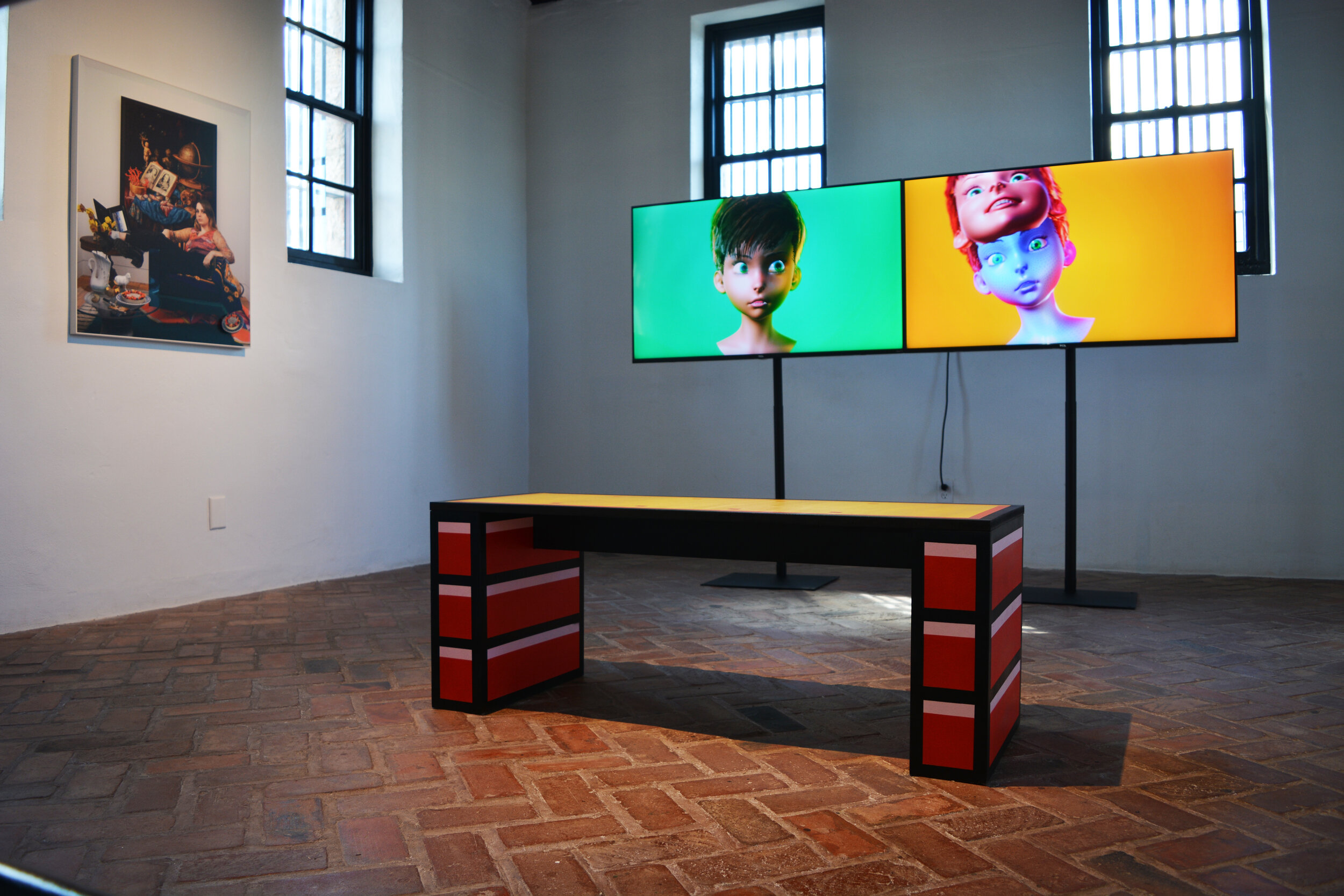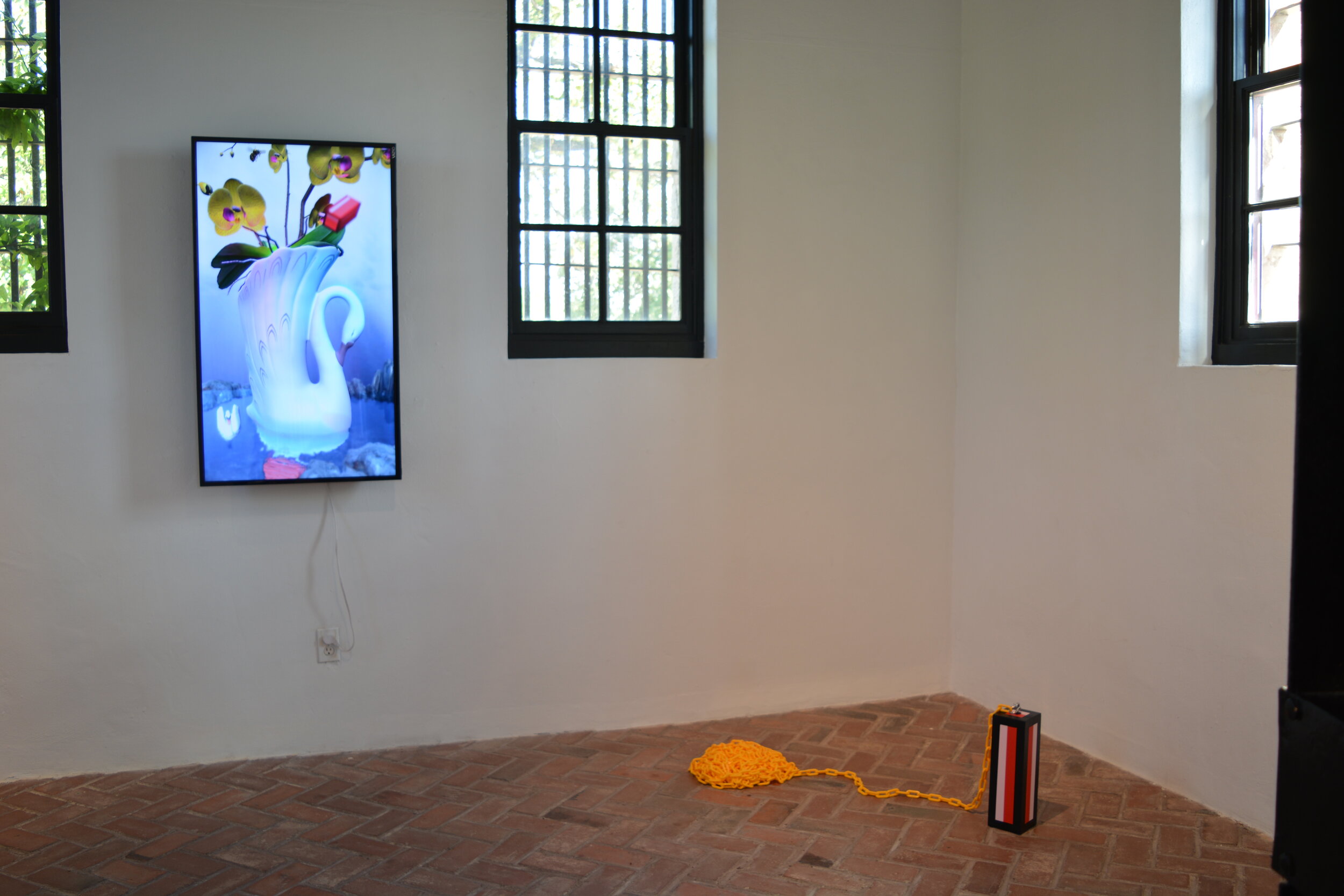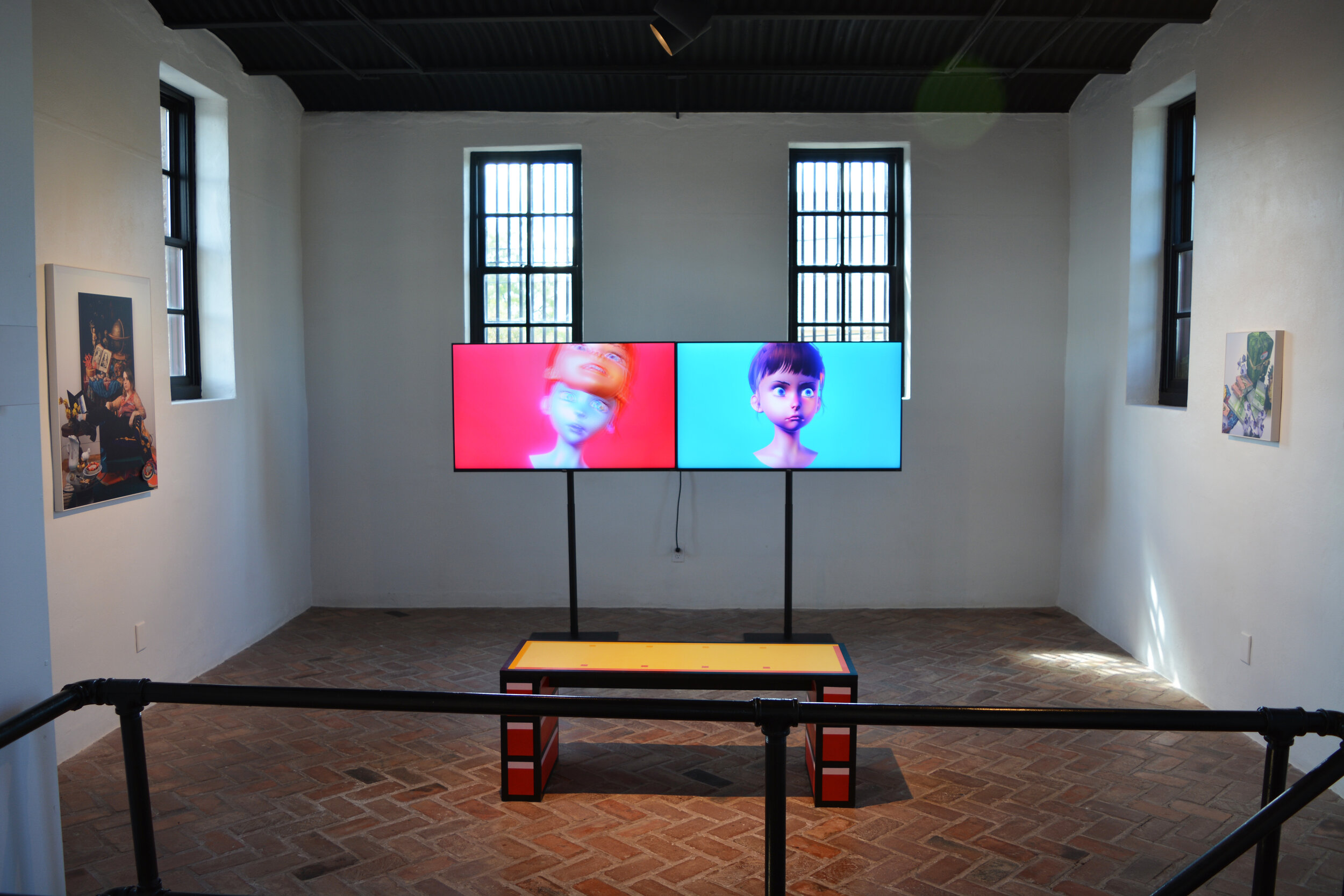Kris Pierce explores notions of power, value, and states of consciousness in the context of our modern digital world through his art works. Specific to the OJAC’s Cell Series exhibition he states: “In the 21st century, identity finds itself divided between physical and digital space. The possibilities of social media, digital avatars, and anonymous chat boards offer a platform where people can say what they want and be what they want, in search of an “upgraded” way of existing. Through a variety of media, including video, real-time 3D, CG modeling, and photography, A Ghost in the Attic, explores the ways in which people project themselves out of the confines of their physical reality into virtual space in an attempt to find the freedoms they lack in their “real” lives.”
It is both fitting and ironic that Pierce’s works deal with peoples’ desire to escape the confines of their physical bodies, given they will exist within the confines and context of former prisoner cells of the OJAC’s 1877 structure. More than one hundred and forty years later we are still attempting to escape current realities by whatever means available.
Pierce works in Dallas, Texas and has exhibited internationally in museums, galleries, and public spaces, including recent solo and group exhibitions at the Hiroshima Art Center, Japan; CICA Museum, Gyeonggi-do, South Korea; Gallerie Se Konst, Falun, Sweden; Réunion, Zurich, Switzerland; The Mac, Dallas; Blue Star Contemporary, San Antonio; the Dallas Museum of Art; and RL Window, Ryan/Lee, New York City.
The 2019 Cell Series is generously supported by McGinnis Family Fund of Communities of Texas in loving memory of Juli Weida McGinnis, 1941-2018, Kathy Webster in memory of Charles H. Webster, the Moody Foundation, Barbra & Jay Clack, Susie & Joe Clack, Jenny & Rob Dupree, Patrick & Amy Kelly.
Still from Love Buzz 1, 2019. HD video on vertical display, 3-minute loop. Courtesy of the artist
Patrick Kelly, OJAC Director and Curator, email interview with Kris Pierce
PK: To begin, please indulge me by briefly explaining the processes you employ in creating your images and videos.
KP: The way I approach my work, while utilizing digital tools, follows what I would consider a traditional process of discovery and development. I'm not overly obsessed with technology as a tool, but computers have always had so much stored potential that felt accessible in an exciting way. They feel like a natural extension of ourselves for better or worse. I'm not sure where exactly that comes from. Maybe it's my time working as an animator in the entertainment industry, maybe it's because my generation will be the last to remember there being no internet before growing up with a PC and everything that came along with that. We're in this unique moment in time where digital tools still feel a bit exotic, though that's changing each year, which I think is a good thing. In the end I feel able to work at a similar pace, mentally and physically, as I did when I was making paintings years ago. That being said, the nature of the work I make does utilize a lot of new technology. Most of the videos and images I have been making for the past 10 years have used a combination of 3D modeling using Maya photogrammetry, which is basically 3D scanning with a camera and game engines (Unity and Unreal) which use a combination of code, real time dynamic physics and rendering. Lately I've started to utilize some brand new stuff, like the depth sensing camera on the new iPhone which I'm using as a tool for capturing facial animation data that gets re-targeted to characters like in one of the pieces in the show. All of these digital tools have a more direct relationship to traditional processes like sculpting, painting and photography that people tend to understand. The decision-making is the same, the environment is different.
PK: So you mentioned “making paintings.” I considered my first question to be an inquiry into your background or training in traditional art forms—we could use the term “plastic arts” to include painting. What type of work were you doing and what led you to use technology as a tool?
KP: I'd say my relationship to art production was very traditional up to a point. I'm sure most people, when they're younger, have a very limited idea about what art can be, and what mediums it can exist within. When I was in college there was no new media program, so you were automatically funneled into something more traditional, so I went through a painting program. A lot of that older work moved in-between painting, photography and video, but I started using a lot of what I use in my current practice as it became more accessible to people on a "consumer" level, which is a relatively new thing. Looking back over the years, technology was this thing that existed in a room on a computer. You went and sat down in front of it, did your thing and then went on with your day. Now it’s something that surrounds us, follows us, influences us and feels inescapable. Those relationships are what I'm interested in with my work. The medium just happens to be a participant in the technological noise we are wrapped up in.
PK: We are at this juncture where there are generations of people who respond differently to technology, from those who fear it (for any number of reasons) to those who embrace it, and everything between. Do you consider those audiences and associated responses when creating a work?
KP: Definitely. I think for me it's those types of dynamics that I find really interesting. We're in a very specific period in history where everyone is trying to find some sort of normalcy in terms of their relationship to technology. Because everyone's idea about what that is, is different, you have interesting social behaviors surfacing in digital space. Because technology is re-writing the rules of social behavior, you have an entirely new class of values. Our presence online, the news we choose to read, who we engage with through social media, all of these things exist in digital space but parlay themselves back into the physical world where they have real-life implications. All of those things relate to the "user" and their relationship to the technology they interface with; those are ideas I am interested in exploring through my work.
PK: There is a lot in that answer to unpack … all interesting to contemplate. There are numerous rabbit holes we could descend, so I’ll shift the conversation a bit here. Since the early 1900s science fiction movies have depicted technology as both good and evil, as a tool in the creation of utopias and dystopias, and other thematic plots. Can you think of a movie that parallels the ideas you are investigating in your work?
KP: I certainly agree with the point you’re making in regard to technology's presence in movies over the years. I'm sure there are countless films/shows that parallel ideas that find themselves into my work. Off the top of my head, the David Cronenberg movie Videodrome, episodes of Black Mirrorand the anime Serial Experiments Lain all feel interesting and relevant today. One movie I loved as a kid, Tron, had a lot of prophetic ideas relating the digital and physical worlds. In short, the movie's main character Kevin Flynn, played by Jeff Bridges, is sucked into a video game where he embodies an avatar named Clu (Codified Likeness Utility) who’s forced to play games in service to the system’s Master Control Program before escaping on a quest to free the corrupted system. Looking back, that film explored relationships in a revelatory way, blurring the lines between characters that existed both in the physical and digital world. By the end of the film, Jeff Bridges’ digital character feels more real and developed than the real-world Flynn we are introduced to in the beginning. In an unexpected way, these blurred lines feel related to our current relationship with digital space. Really, at the end of the day, it’s the current state of in-betweenness that I find interesting—in-between physical and virtual, digital and analog, real and illusion. All that being said, I choose to remain neutral in opinion. I do however find it interesting to let these ideas become major characters within the work that I develop in hopes of them revealing interesting things about the unique moment in time in which we live.
PK: Can you briefly describe one of the works to be included in your OJAC exhibit and how, or if, this “in-between” idea is demonstrated?
KP: There are several works in the show that originate and follow a more historic definition of photographic portraiture. The central image of each work's subject is captured in physical space with a camera, but takes on a unique set of possibilities when imported into the computer where any manner of environment can be fabricated. This digital environment allows me to re-write the subject into any number of situations, and assert unique power over the relationships I want to create in the work. This is meant to run in context to the ways people project themselves into social platforms like Instagram or Facebook. The nature of these platforms feed an environment where users instinctively create advertisements for themselves. A number of digital tools exist to manipulate one's image in service of one's personal narrative—a narrative that exists in-between physical and digital, real and fake, familiar and foreign. These relationships feel particularly relevant as technology allows users to fake any manner of video, image or identity. The implications of a world where our relationship to imagery no longer represents the truth becomes exceedingly complicated and dangerous when parlayed into social, political and romantic situations.
PK: This topic of “truth” is also relevant to the OJAC’s other exhibit that will be on view during yours. It is titled Nobody’s Fooland features trompe-l’oeil paintings. In a short statement I recently wrote tying the shows together, I quoted Picasso who famously said, “Art is a lie that makes us realize truth …” Not a question, but I do think it’s interesting that we seem to think this idea of what is “true” or “fake” is something new, likely due, to the current political rhetoric. It’s just getting very weird, and as you say, “complicated and dangerous.” I don’t think many people see it the way you do. Okay … so tell me about one of the videos.
KP: I like the connections you're making; there are certainly some timeless themes at play. One video, I would describe as central to the exhibition, explores the freedom that one finds in anonymity, specifically on the Internet. The core content comes out of confessions people make on internet chat boards. Sad, funny, optimistic, desperate; they really span the entire range of human vulnerability. I’m interested in the way the internet offers an environment where people feel empowered to connect and share very personal things about themselves in an effort to realize something they can’t find in the physical world. That's very interesting to me. On the flip side, since it’s a public space, there is a voyeuristic component where one can interlope in and out of these peoples’ lives; or in my case, co-opt their words into another context. That's certainly a consideration when developing the work. It's the nature of the connected world, a world where control is given, capitalized on and then sacrificed to the larger network of people engaged in it. Ultimately, we find ourselves connected in unexpected ways, the post-internet era could be defined by that—good or bad. Freedom is a door that swings both ways.





